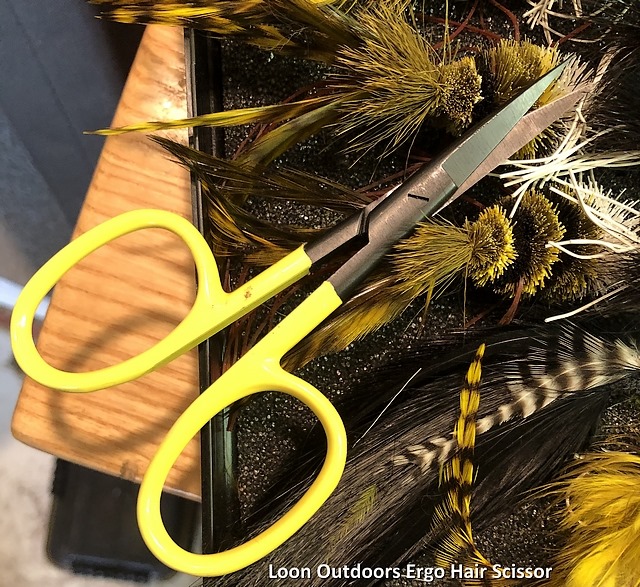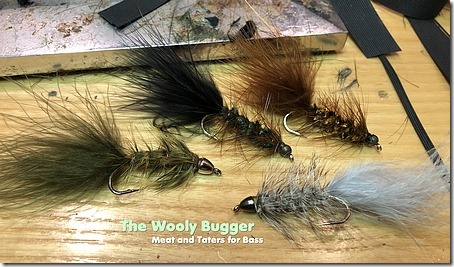The pandemic has accelerated my conversion from trout fisherman to bass fisherman due to the unknowns associated with food, lodging and travel. I’ve shelved all the gossamer and petite gear needed for trout fishing in favor of Styrofoam, hair, rubber legs, and hooks capable of severing your Carotid artery with an errant cast.
Tying flies for bass is the “Widow Maker” for most marriages, as the production of a dozen 2/0 poppers involves half a deer hide, acres of marabou and brightly dyed Grizzly hackle, most of which winds up clinging to your lap or blowing about your tying room at the whim of your air conditioning.
I keep reaching for my “trout” scissors to cut bead chain eyes and saw through Stinger hooks and realized they were better served staying in the drawer given their delicacy. Unable to find my old serrated edge heavy scissors, I picked up a pair of the Loon Outdoor Ergo Hair scissors to replace them. At $15 per pair, these scissors are priced well considering the potential for destroying them while restocking your fly box.
Tying big deer hair poppers can shorten the life of traditional delicate scissors as there are additional pressures that go hand in hand with larger flies.
Volume: Large bass poppers require many times the materials of smaller trout flies. That translates into cutting larger volumes of material with each cut of your scissor. As leverage plays into the physics of scissor cuts – the longer the scissor the more force is applied to the fulcrum area, the small screw holding the scissors together. Stainless steel is a “soft” steel (compared to others), and the screw steel is typically “harder” than Stainless, which ensures this excess force will eventually deform the screw hole and loosen the scissor over time.
Obscurity: Tying big lumpy hair poppers means you have an enormous wad of hair lashed to your hook prior to trimming the final shape. As the majority of the hook is hidden , it’s very easy to close the scissor on the shank, point, or eye – simply because you couldn’t see it while trimming. Whacking a hook point with your scissors is bad for the tips and for the screw area, as the steel of a hook is “harder” than the steel (often Stainless) used to make the scissor. Hook steel can easily take the points off of a Tungsten scissor, as Tungsten is among the hardest of all steels – but it is also among the most brittle.
Dirt: Carving large amounts of deer hair off of the hide is a dirty business. While animal hides are cleaned and washed prior to being parted up for packaging, there is still a lot of foreign material trapped in the hair. Dirt, debris, dried blood, seeds, and everything else trapped in the under fur will be in the path of your scissors each time you make a cut of hair, and that additional wear adds over time.
Bulk: Cutting through three-quarters of an inch of Elk hair takes considerably more effort than trimming a mallard feather, yet most tiers expect the results to be identical. Cutting large amounts of material with small scissors requires the scissor to be closed slower than when it cuts a small feather – or the screw area will suffer. This is the most common way to deform the screw hole, cutting too much too quickly, and either the handles bend as you close them or the screw hole widens to accommodate the excessive pressure. Scissors loosen as they age, but it’s actually deformity of the screw hole that causes all the extra play – rather than wear. If you are tying a lot of large flies or the materials are quite tough it’s better to switch to a larger scissor with the backbone to sheer through the material with less strain on the fulcrum area.
Today, Bulk and habit were the root of my problems, as I kept reaching for the fine point trout scissor when I should have used a larger set with serrated blades. Serration is always useful when trimming hair as the fibers cannot slide out of the scissors ahead of the cut, the fibers tend to catch in the serration and ensures everything gets trimmed proper. Note that this is both good and bad, as the serrated scissor will grip and make absolute cuts – and you can remove too much material if you’re unused to them.
The Loon Ergo serrated scissors are a 4.5” (powder-coated stainless steel) scissor with superb tips and a light serration down one of the blades. The large finger holes, hence the “ergonomic” designator, are quite comfortable for extended tying sessions, and there is enough “beef” in the scissor frame to snap them closed without feeling the handles flex – which is a good tell that the scissor is over capacity on the cut.
At $15 the price is really cheap, prompting me to order a second set for use with conventional tackle, trimming braid and heavy monofilament where that serrated edge will prove extra useful..
As my tying room is currently bereft of carpet due to a “slab leak” and having to jack hammer the concrete pad beneath for the repair, I should mention that I managed to drop these scissors on their points and bent both tips in a dramatic fashion. Stainless steel is a soft steel, so I was able to restore the points to their original shape by dragging them across my vise barrel several times. This is not a failure of design or an inherent weakness in the quality of the product – rather this is what happens when good scissors and fine tips meet an immovable object.
Great scissor for a great price – and with the large finger holes even the hammy handed should find these comfortable.
Note: This is an unsolicited quick review of this product. The scissor was purchased at full retail from a shop.



